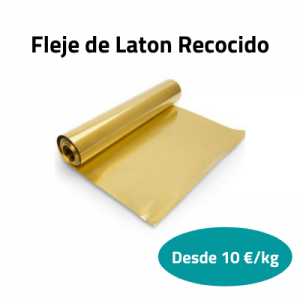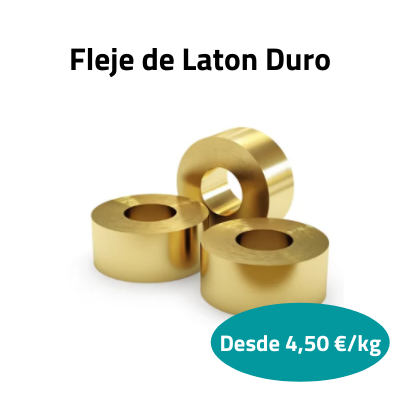Brass strip: how to go from kilograms to meters
The brass strapping It is a material widely used by artisans and jewelers, since its characteristics make it ideal for handling and transformation. Thanks to its bright golden color, and its thin thicknesses, we can manipulate it, cut it and even create reliefs by exerting a little force on it.
When we want to make a craft with brass strapping, it is very common to wonder how much brass strapping I need to carry out my project. Normally, brass strapping is bought by kilograms, so the question arises as to how many meters I am buying in a kilogram, and therefore how many kilograms should I buy.

In order to resolve this question, we are going to follow a series of steps to find out how much quantity of brass strapping needed.
1. Know the thickness and width
The brass strapping It is a highly variable material, there are many thicknesses and widths on the market, these are data that we need to know both to carry out our project correctly, and to find out how many meters we are buying.
- Strap thickness, the thickness of the strap will determine how manageable the material is, so that you can get an idea, a strap of 0.1 millimeters is equivalent to the thickness of a sheet of paper, being very manageable and easy to cut. The thicker the strapping, the more difficult it will be to manipulate.
- strapping width. The strap width is something very variable, since the factories cut from large straps, smaller straps. Normally the thickness of the strip usually varies from 300 to 400 millimeters wide.
Once we know the thickness and width we need for our project we can start calculating.
2. Find out how many kilograms there are in a meter
We want to know how many kilograms there are in one meter of the brass strapping we want. But first, it must be taken into account that in order to calculate it, it is necessary to use the density of brass, which is normally 8.5 g/cm3, although there may be small variations depending on whether the strip is hard, annealed or semi-annealed. So the calculations will be approximate.

To find out how many kilograms there are in a meter of brass strap we are going to use the following formula:
Width * Thickness * 8.5 / 1000 = kilograms/meter
To make it clearer, we are going to use an example, if the brass strap we want has a thickness of 0.6 millimeters and a width of 320 millimeters, the formula would be the following:
320*0.6* 8.5/1000 = 1.632 kilograms/meter
This result is equivalent to saying that a meter of brass strapping weighs 1,632 kilograms.
3. Rule of three
Remember that our goal is know how many meters we have in a kilogram of brass strapping, since it is normally the format in which it is purchased. To find out this we only have to apply a rule of three to be able to find out the equivalent.
To make it clearer, we will use the previous example with the brass strap measure of 0.6x320mm. We saw that there are 1,632 in a meter of thread, so:
1,632 kilograms = 1 meter
1 kilogram = x meters
If we solve the rule x=1*1 /1,632 the result is equal to x = 0.61 meters. Therefore, in a kilogram of brass strapping there are 61 centimeters strapping approx. You can apply this rule to any measure you want to buy from Brass strapping.
See all the strap measurements of we own in Zavala. Visit all our metal products.




I don't know whether it's just me or if everyone else experiencing issues with your site.
It seems lime some of the written text on your content are running off the screen. Can someone
else please provide feedback and let me know if this is happening to them as
well? This may be an issue with my browser because I've had
this happen before. Appreciate it
Take a look at my page https://penzu.com/p/6bb0260c
Thank you very much for the recommendation, we will review the format of the blog on the web to know if there are problems when performing the translation, since the original post is in Spanish. Hello